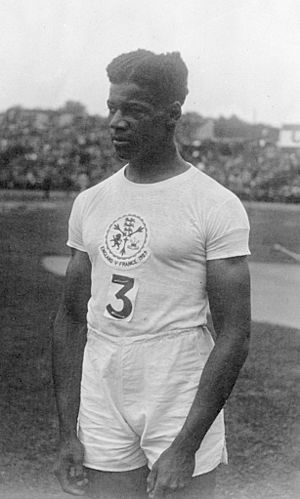Jack London (athlete) facts for kids

Jack London in 1929
|
||||||||||||||
Quick facts for kids Personal information |
||||||||||||||
|---|---|---|---|---|---|---|---|---|---|---|---|---|---|---|
| Born | 13 January 1905 Georgetown, British Guiana |
|||||||||||||
| Died | 2 May 1966 (aged 61) London, England, United Kingdom |
|||||||||||||
| Height | 1.83 m (6 ft 0 in) | |||||||||||||
| Weight | 75 kg (165 lb) | |||||||||||||
| Sport | ||||||||||||||
| Sport | Athletics | |||||||||||||
| Event(s) | 100 m, 200 m, high jump | |||||||||||||
| Club | Polytechnic Harriers | |||||||||||||
| Coached by | Sam Mussabini, Albert Hill | |||||||||||||
| Achievements and titles | ||||||||||||||
| Personal best(s) | 100 m – 10.6 (1928) 200 m – 22.2 (1928) HJ – 1.88 m (1927) |
|||||||||||||
|
Medal record
|
||||||||||||||
John Edward London (born January 13, 1905 – died May 2, 1966) was a talented British athlete. He was best known for his speed in the 100 metres race. Jack London was born in British Guiana, which is now known as Guyana. He achieved great success at the 1928 Summer Olympics in Amsterdam, winning both a silver and a bronze medal.
Contents
Early Life & Training
Jack London moved to London, England, when he was a child. Later, his family moved back to British Guiana. There, he attended Queen's College in Georgetown.
After returning to England, London studied at the Regent Street Polytechnic. He joined the Polytechnic Harriers, a sports club, where he was coached by Sam Mussabini. In October 1922, he was chosen as the captain of the club.
Using Starting Blocks
Jack London was one of the first athletes to use starting blocks. These blocks help sprinters get a powerful start. Before this, runners would dig small holes in the track for their feet. Using starting blocks was a new and smart way to begin a race.
In July 1927, London showed his speed by winning the 100 metres race. This was at a competition between England and France held at Stamford Bridge. He finished the race in a quick 10.7 seconds. Later that year, in October, he won both the 100 metres and 200 metres races in Paris.
Olympic Success in 1928
Jack London represented Great Britain at the 1928 Summer Olympics in Amsterdam, Netherlands. He performed incredibly well in the 100 metres race. In the semi-final, he matched the Olympic record, finishing in 10.6 seconds.
Winning Medals
In the final of the 100 metres, Jack London won the silver medal. He finished just behind Percy Williams from Canada. He then earned a bronze medal as part of the 4×100 metres relay team. His teammates were Cyril Gill, Edward Smouha, and Walter Rangeley. Their team finished behind the United States and Germany.
Jack London made history at these Olympics. He was the very first athlete to use starting blocks in an Olympic Games. For his achievements, he received the S. A. Mussabini memorial medal and the Studd Trophy in 1928.
Later Athletic Career
After the 1928 Olympics, Jack London continued his training with a new coach, Albert Hill. In July 1929, he became the first British sprinter in five years to win the Amateur Athletic Association's 100 yards title. He was also a talented high jumper during this time.
Unfortunately, a leg injury in 1930 slowed down his athletic career. He did compete in a 4×100 metre relay for England against Germany in 1931. However, he was not chosen to compete in the 1932 Summer Olympics in Los Angeles.
Life After Sports
After retiring from athletics, Jack London explored a different career path. He became an entertainer. In 1931, he played the piano in the first show of Noël Coward's musical Cavalcade. This musical was performed at the Theatre Royal, Drury Lane.
He also appeared in a movie! In 1938, he was in the comedy film Old Bones of the River. This movie was made by Gainsborough Pictures and starred Will Hay.
Jack London also shared his knowledge of athletics. In 1948, he co-wrote a coaching book called The Way to Win on Track and Field. He wrote it with athletics journalist Joe Binks.
See also
 In Spanish: Jack London (atleta) para niños
In Spanish: Jack London (atleta) para niños

